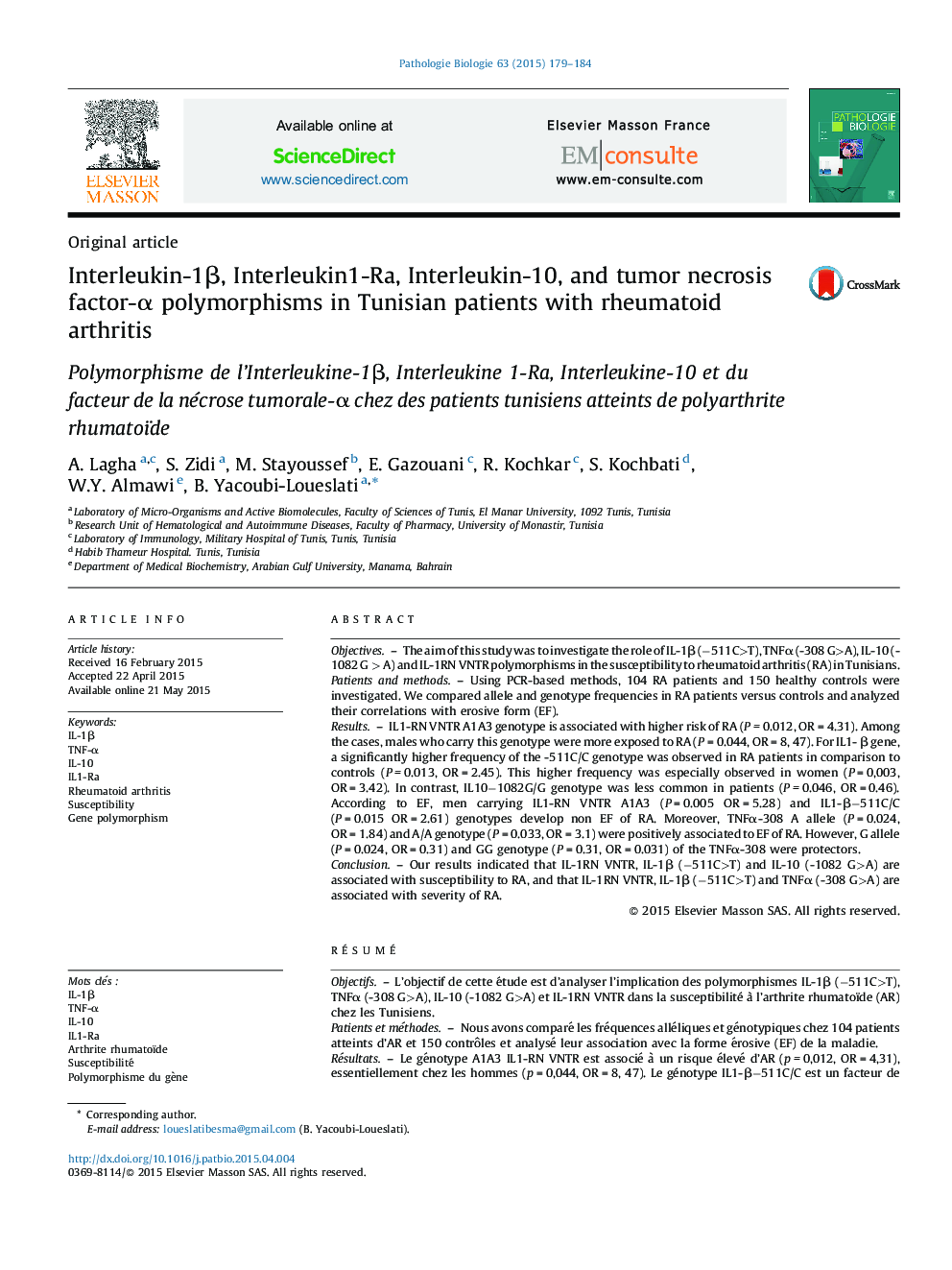| کد مقاله | کد نشریه | سال انتشار | مقاله انگلیسی | نسخه تمام متن |
|---|---|---|---|---|
| 4135860 | 1606678 | 2015 | 6 صفحه PDF | دانلود رایگان |

ObjectivesThe aim of this study was to investigate the role of IL-1β (−511C>T), TNFα (-308 G>A), IL-10 (-1082 G > A) and IL-1RN VNTR polymorphisms in the susceptibility to rheumatoid arthritis (RA) in Tunisians.Patients and methodsUsing PCR-based methods, 104 RA patients and 150 healthy controls were investigated. We compared allele and genotype frequencies in RA patients versus controls and analyzed their correlations with erosive form (EF).ResultsIL1-RN VNTR A1A3 genotype is associated with higher risk of RA (P = 0.012, OR = 4.31). Among the cases, males who carry this genotype were more exposed to RA (P = 0.044, OR = 8, 47). For IL1- β gene, a significantly higher frequency of the -511C/C genotype was observed in RA patients in comparison to controls (P = 0.013, OR = 2.45). This higher frequency was especially observed in women (P = 0,003, OR = 3.42). In contrast, IL10−1082G/G genotype was less common in patients (P = 0.046, OR = 0.46). According to EF, men carrying IL1-RN VNTR A1A3 (P = 0.005 OR = 5.28) and IL1-β−511C/C (P = 0.015 OR = 2.61) genotypes develop non EF of RA. Moreover, TNFα-308 A allele (P = 0.024, OR = 1.84) and A/A genotype (P = 0.033, OR = 3.1) were positively associated to EF of RA. However, G allele (P = 0.024, OR = 0.31) and GG genotype (P = 0.31, OR = 0.031) of the TNFα-308 were protectors.ConclusionOur results indicated that IL-1RN VNTR, IL-1β (−511C>T) and IL-10 (-1082 G>A) are associated with susceptibility to RA, and that IL-1RN VNTR, IL-1β (−511C>T) and TNFα (-308 G>A) are associated with severity of RA.
RésuméObjectifsL’objectif de cette étude est d’analyser l’implication des polymorphismes IL-1β (−511C>T), TNFα (-308 G>A), IL-10 (-1082 G>A) et IL-1RN VNTR dans la susceptibilité à l’arthrite rhumatoïde (AR) chez les Tunisiens.Patients et méthodesNous avons comparé les fréquences alléliques et génotypiques chez 104 patients atteints d’AR et 150 contrôles et analysé leur association avec la forme érosive (EF) de la maladie.RésultatsLe génotype A1A3 IL1-RN VNTR est associé à un risque élevé d’AR (p = 0,012, OR = 4,31), essentiellement chez les hommes (p = 0,044, OR = 8, 47). Le génotype IL1-β−511C/C est un facteur de risque (p = 0,013, OR = 2,45) essentiellement chez les femmes (p = 0,003, OR = 3,42). En revanche, le génotype G/G IL10−1082 est moins commun chez les patients (p = 0,046, OR = 0,46). Les hommes portant le génotype A1A3 de l’IL1-RN VNTR (p = 0,005 OR = 5,28) et C/C de l’IL1-β−511 (p = 0,015 OR = 2,61) développent une forme non érosive d’AR. De plus, chez les patients présentant une forme érosive d’AR, l’allèle A (p = 0,024, OR = 1,84) et le génotype A/A du TNFα-308 (p = 0,033, OR = 3,1) sont positivement associés à la maladie, alors que l’allèle G (p = 0,024, OR = 0,31) et le génotype GG (p = 0,31, OR = 0,031) sont moins fréquents chez les malades.ConclusionL’IL-1RN VNTR, IL-1β (−511C>T) et l’IL-10 (-1082 G>A) sont associés à une susceptibilité à l’AR et l’IL-1RN VNTR, l’IL-1β (−511C>T) et le TNFα (-308 G>A) sont associés à la sévérité de l’AR.
Journal: Pathologie Biologie - Volume 63, Issues 4–5, September 2015, Pages 179–184